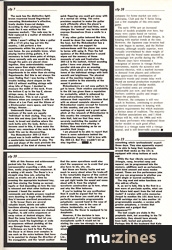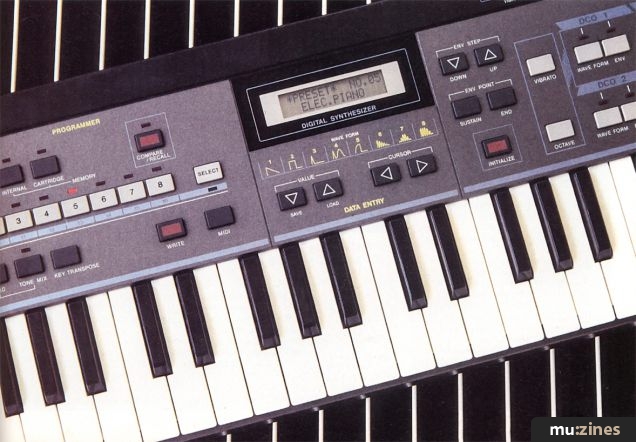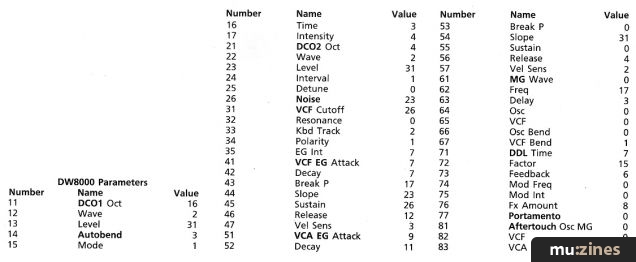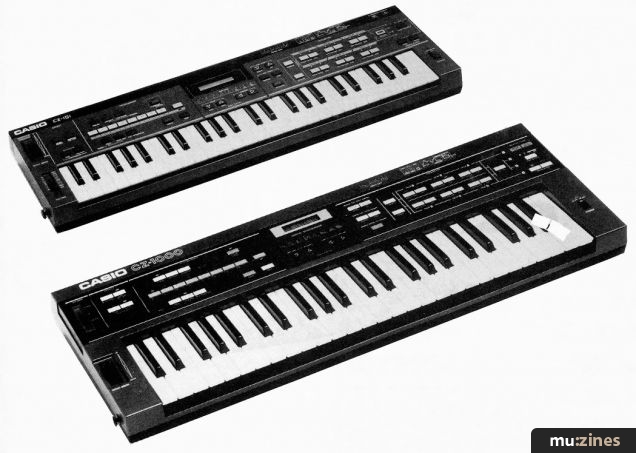Magazine Archive
Home -> Magazines -> Issues -> Articles in this issue -> View
Casio CZ101 | |
Article from One Two Testing, January 1985 | |
cheap, programmable, digital, poly...

IT'S SUNDAY morning. Outside a grubby sky looks depressed enough to slit its wrists, if it could find them among the clouds. But that's nothing. British scientists can look far more miserable. A panel of them are moaning from behind the TV screen about how far British science has fallen behind the rest of the world. In 1970, they say, we had 17 per cent of the patents registered that year. By 1983 that figure had plummeted to 8 per cent. Meanwhile, one country had accelerated its invention, study and genius beyond all possible expectations. In 1983 they had a ludicrous 36 per cent of the patents registered that year. Who were these intellectual giants??
Outside the sky began to drizzle sulkily in grey anticipation as another sourly unsuccessful applicant for the brain drain gloomed at Camera 3. "Japan."
We, of course, have known the truth of this situation for years, being in a prime position to appreciate Japan's finest microprocessor efforts in the form of cheap, programmable synths. There's a good chance that within the aforementioned 36 per cent of patents lies the groundwork for the CZ-101.
Perhaps it would read something like 'programmable, polyphonic digital synthesiser with internal space for 32 sounds' which on the surface would not replace 'Dune' as thrilling bedtime browsing. Perhaps when you append 'Casio's first professional keyboard', and 'recommended retail price £395' to the statistics, the prose hots up, and the professors pour themselves another large scotch.
The shared theme of this month's two keyboard reviews (see the Oscar elsewhere) is electronic accessibility. The CZ-101 impresses powerfully, for two reasons, (a) for the first time you can get at the digital waveform generation, filtering and envelope generation of a Casio synth and programme it yourself and, (b) how closely the CZ can then be brought to resemble an analogue poly.
The CZ-101 is ostensibly an eight-note polyphonic with two digitally-controlled oscillators. In truth, each oscillator is only capable of producing four notes so you need both side-by-side so that eight notes can be held down. For the best sounds — at least 75 per cent of which require the oscillators to be layered on top of each other — you are reduced to four-note polyphony.
The other drawback in this layered area is the Casio's method of key scanning and triggering. The keys operate on new note priority — any new note will be played and an old one (four notes behind in the order of things if the DCOs are layered) will be stolen back in order to provide the space. This system is excellent when you're a less than brilliant technician since you don't have to worry so much about your fingering. Unfortunately, it does away with the idea of sustaining a chord in your left hand and playing solos with the right. Even if you continue to hold down, say, two bass notes at the bottom of the keyboard, as soon as four new notes have been played at the top, these 'originals' will disappear unless you lift your fingers off the keys and sound them a second time. You do find your sound being snatched away from you. The importance of this habit lessens substantially when you stick to single DCO, eight-note polyphony or when you view the CZ as a top line or chord synth additional to your present set up, or as a home recordist's workhouse. It excels at both, but perhaps is not ready to stand alone, on stage, unaccompanied.
Physically the CZ-101 is a lightweight, mini keyboard with three and a half octaves worth of approximately half size keys (a full-sized version is on the way). The front panel splits into four sections — performance (portamento, mono modes, etc), programme selection, display and data entry, and parameter selection.
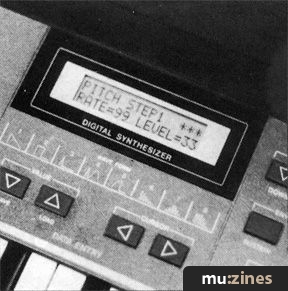
Central of these is the two-level LCD screen which supplies the essential prompts and values. Most of the parameters are programmable at 100 levels from 0-99 which is a good, detailed range compared with the 8- and 16-step options of early, budget programmables.
Sounds are created by blending waveforms for each of the two digitally controlled oscillators then treating them with the DCW (Digitally Controlled Waveshaper — analogous to an analogue filter) plus a digitally controlled amplifier.
Where the impressive trickery enters is at the buttons marked ENV. Each DCO, DCW and DCA has its own envelope generator theoretically able to determine eight levels between 0 and 99 and then eight different rates at which the DCO pitch, DCW shape or DCA volume travel to get from one to the other. It's a digital roller coaster where you decide how high and low the track runs and at what speed the buggy moves on its journey.
This, by no small coincidence I would hazard, exhibits a close resemblance to Yamaha's FM system of synthesis where the envelope generators again operate through rate and level settings. The Casio's is not (and cannot) be as sophisticated a system as the Yamaha's, but it can still manage a great deal — think about it, all that independent and involved control over the digital/analogue equivalents of pitch, filter and volume. But how does all this happen? Depressed British Scientists begin here.
At the heart of Casio's sound creation is a technique they call Phase Distortion. The information and therefore the pattern of a sine wave is written into ROM (Read Only Memory) and different waveforms are created by altering the way and speed in which this sine wave is 'read out' of the memory. If read in a normal way, a sine wave is produced, but if, for example, the first half of the sine wave info is read out very rapidly and the second half much more slowly this distorts the shape so it begins to resemble a sawtooth waveform.
It's not then, such a large jump to understand how the envelope generator attached to the DCW could be made to read the ROM sine wave at many different rates and levels, thus changing the waveshape and the quality of the sound within each individual note.
Before you get that far, the CZ already has eight basic waveforms that can be mixed together in pairs for each DCO. The choice is sawtooth, square, pulse, double sine, saw-pulse plus resonance I, II and III. This last trio have the profiles of sawtooth, triangle and square waveforms but with many peaks and troughs packed within the shape giving distinct ring-modulatory feels to the sound.
In practice most of us looking for new sounds start with an existing programme and modify it. But for argument's sake, we'll start from scratch. Punch the button for DCO I Waveform and the LCD will read WAVEFORM across the top then below FIRST =________ SECOND =______. The eight basic shapes are inscribed on the panel underneath the screen and beneath those are four buttons. The first two step the parameter values up or down, the second two move a cursor in the LCD window left or right to fall under the parameter you wish to reprogramme. With the cursor under FIRST we up the value to 2 to select the square wave, then move the cursor right, up the value to 5 for the saw-pulse and that DCO is fixed.
For the sake of easy explanation, let's say we've jumped a couple of sections and have gone straight to the DCA envelope. Now the LCD will display on top STEP 1 *** and below RATE=________ LEVEL =_______. If you wanted the sound to come on instantly at maximum volume you'd enter a level of 99 and (bizarrely) a rate of 99. A slow attack would be something closer to a rate of 50. Now you want to construct the initial decay. Press the ENV STEP UP button to the right of the LCD and the screen will now display STEP 2 and again the corresponding gaps. A slow decay to half volume, perhaps? Then put the level at 50 and the rate at 30, and so on. The gap marked *** is for two pre-set instructions SUSTAIN and END, added by their own buttons also to the right of the LCD. Once SUSTAIN is entered the sound stays at the last programmed level for as long as your finger is on the key. END is a convenient way of ensuring the sound will cut off at zero when the envelope generator has finished its work. It can be entered at any step.
The SUSTAIN instruction shouldn't be too rapidly dismissed. If you enter it at step 4, for example, that leaves you with another four steps and levels which can be programmed to effect the sound after your fingers have been taken off the keys. This ploy can be used to produce distant decays that sound like reverb, or other strange after thoughts to the sound... even digital echo impersonations.
Now imagine the same acoustic perambulations applied to the pitch and the waveshape of the sound. In their instruction manual, Casio suggest artificial portamentos by encouraging the oscillators to slide upwards to the beginning of each note, or create wah-wah imitations by taking the DCW up and down in level. Yeah, you say, but we can already do this on an analogue synth with env to pitch control and simple LFOS.
(A), you're miserable buggers and, (B), that's only the start of the Casio's talents. The ability to dictate eight stages of an envelope generator with such control contribute to two of the factors I find most appealing about digital synthesis — the detail and sophistication of the finished sound and the promise that you can keep going back to the synth and constantly discover new effects — a boast which can now be very seldom made about analogue synths.
Earlier I said that at least 75 per cent of the best sounds the CZ-101 makes are when the oscillators are overlayed. This is not just because of the extra depth such (adjustable) detunings always lend to the instrument. It's also down to the subtle complexities introduced by having the two DCOs operating under separate envelope generators, each meandering through changes in pitch, tone and volume.
So how does the CZ sound? Surprisingly it's a strange mixture between analogue and digital. The clean, metallic and resonant qualities of those final three preset waveforms do approach the tendencies of, say, a Yamaha DX9 though not with the depth nor polyphony the latter can achieve.
Also Casio have (thank God) finally produced a synthesiser that can turn out decent, monophonic bass lines and manufacture a few growling lead solo voices (though the pitch bend wheel at the top left of the control panel does border on the M. Mouse). The 16-factory set programmes have some taut brass settings and a couple of string voices that have inherited the original sweet-but-small affliction of digital strings. Fortunately the ability to layer up the oscillators gets them round this, but massive orchestral washes — particularly if you want more than four notes worth of them — are not the CZ's strongest point.
An over-critical keyboardist judging on sound alone might say the Casio falls uncertainly between the ana/dig benchmarks, but that's overlooking the price which brings aspects of both of those technologies to some pockets for the first time. In that sense it's remarkable.
Have we missed anything spec wise? MIDI, naturally, assignable on 16 channels though it seems only the basic functions can be transferred. Patch changing ought to be among them but no one had had a chance to hook up the first British CZ sample when it came across. It was established enough to play the CZ-101 from a full-sized keyboard, and that felt immeasurably better.
All the control panel buttons are real (not pressure pads) with light, positive actions and the synth itself weighs no more than 3.2kg including the six SUM-1 type batteries. These also serve as the backup for the programme memory which could be a bit dodgy if you've got some precious programmes. There is a protect function which automatically shuts down the CZ when it's in danger of stealing the last of the juice. A separate backup battery would have been better as well as being something which 'professionals' expect these days. They also apparently expect to be able to hang their keyboards around their necks as the 101 is equipped with strap buttons at each end.
While the four vibrato waveforms (triangle, ramp, inverted ramp and square) can be programmed into the memory, additions such as portamento, pitch bend amount and mono modes cannot. These are live performance jobs but you can programme in whether you want single or layered oscillators.
The ring mod and noise functions are also add-on effects.
If, as we're told, this is the first in a new wave of pro-Casio synths, what can the future hold apart from the full sized model? A version with extra memories (forgot to mention the 101 does have a RAM cartridge slot to take another 16 programmable sounds), a version with greater polyphony, a version that samples and a gadget that sequences???
The last couple are stabs in the prophetic dark, but according to the TV scientists, they should have already been built, tested and patented. Perhaps this IS the keyboard that Kate Kestrel will be playing in the 21st century. Better get one before it starts raining again.
CASIO CZ-101 poly: £395
Contact: Casio, (Contact Details).
Also featuring gear in this article
Casio CZ-101 - Professional Polyphonic Synth
(IT Jan 85)
Casio CZ101 - Synthcheck
(IM Feb 85)
Digital Dynamite
(ES Jan 85)
System Power
(SOS Dec 85)
Total recall - Cosmology
(MX Mar 95)
Patchwork
(EMM Jun 85)
Patchwork
(EMM Feb 86)
Patchwork
(EMM Mar 86)
Patchwork
(EMM Apr 86)
Patchwork
(EMM May 86)
Patchwork
(EMM Jun 86)
Patchwork
(EMM Aug 86)
Patchwork
(EMM Sep 86)
Patchwork
(EMM Oct 86)
Patchwork
(MT Nov 86)
Patchwork
(MT Dec 86)
Patchwork
(MT Apr 87)
Patchwork
(MT May 87)
Patchwork
(MT Jun 87)
Patchwork
(MT Aug 87)
Patchwork
(MT Oct 87)
Patchwork
(MT Mar 88)
Patchwork
(MT Apr 88)
Patchwork
(MT Apr 89)
Patchwork
(MT Aug 89)
...and 19 more Patchwork articles... (Show these)
Browse category: Synthesizer > Casio
Featuring related gear
Casio CZ 5000
(12T Jul 85)
Casio CZ-230S - SynthCheck
(IM Jul 86)
Casio CZ-5000 - Synthcheck
(IM Aug 85)
Casio CZ230S Keyboard
(EMM May 86)
Casio CZ3000 - The Obvious Solution?
(SOS Apr 86)
Casio CZ3000 Polysynth
(EMM Feb 86)
Casio CZ3000 Synth
(12T Apr 86)
CZ Top - Casio CZ5000
(ES Jul 85)
Sound And Vision - CZ Editing Software
(EMM Mar 86)
The Synths Of The Year Show - Synthcheck
(IM Dec 85)
Patchwork
(EMM May 86)
Patchwork
(EMM Aug 86)
Patchwork
(EMM Oct 86)
Patchwork
(MT Feb 87)
Patchwork
(MT Mar 87)
Patchwork
(MT Aug 88)
Patchwork
(MT May 89)
Patchwork
(MT Sep 89)
...and 7 more Patchwork articles... (Show these)
Browse category: Synthesizer > Casio
Browse category: Software: Editor/Librarian > Joreth Music
Browse category: Software: Editor/Librarian > Steinberg
Publisher: One Two Testing - IPC Magazines Ltd, Northern & Shell Ltd.
The current copyright owner/s of this content may differ from the originally published copyright notice.
More details on copyright ownership...
Review by Paul Colbert
Help Support The Things You Love
mu:zines is the result of thousands of hours of effort, and will require many thousands more going forward to reach our goals of getting all this content online.
If you value this resource, you can support this project - it really helps!
Donations for April 2024
Issues donated this month: 0
New issues that have been donated or scanned for us this month.
Funds donated this month: £7.00
All donations and support are gratefully appreciated - thank you.
Magazines Needed - Can You Help?
Do you have any of these magazine issues?
If so, and you can donate, lend or scan them to help complete our archive, please get in touch via the Contribute page - thanks!


